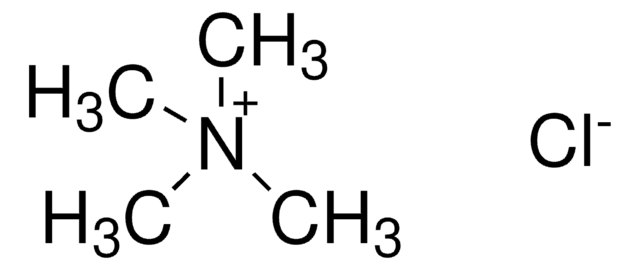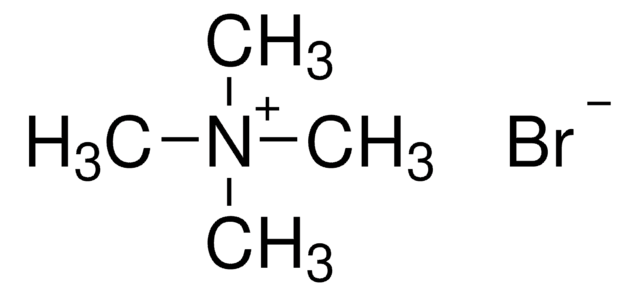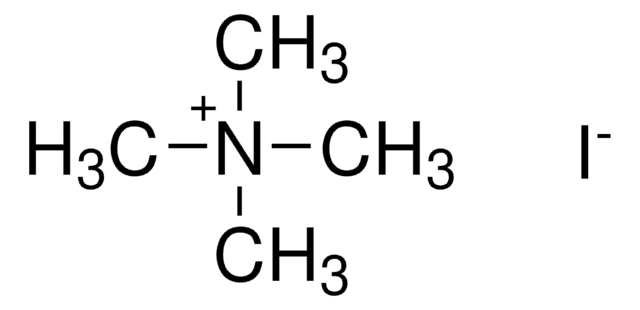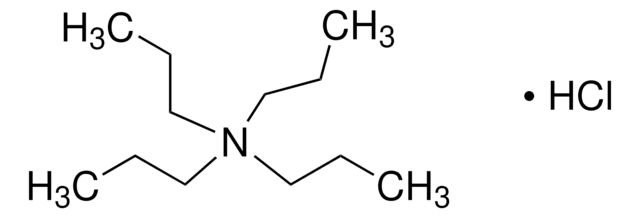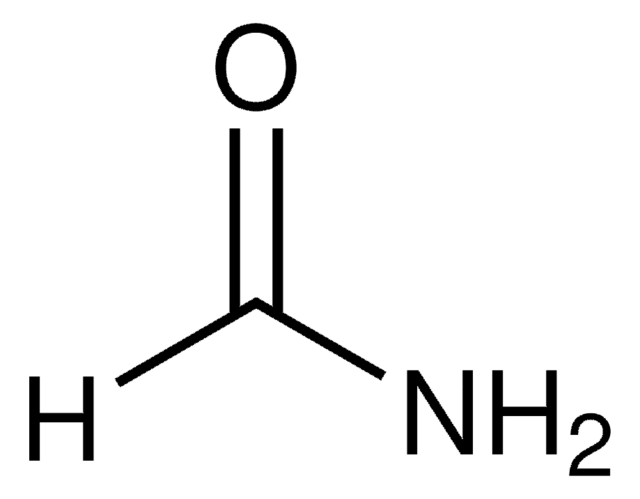87718
Tetramethylammonium chloride
BioUltra, for molecular biology, ≥99.0% (AT)
Sinónimos:
TMA
About This Item
Productos recomendados
grade
for molecular biology
product line
BioUltra
assay
≥99.0% (AT)
form
crystals
impurities
DNases, none detected
RNases, none detected
insoluble matter, passes filter test
phosphatases, none detected
proteases, none detected
mp
>300 °C (lit.)
solubility
H2O: 6 M at 20 °C, clear, colorless
anion traces
bromide (Br-): ≤500 mg/kg
sulfate (SO42-): ≤50 mg/kg
cation traces
Al: ≤5 mg/kg
As: ≤0.1 mg/kg
Ba: ≤5 mg/kg
Bi: ≤5 mg/kg
Ca: ≤10 mg/kg
Cd: ≤5 mg/kg
Co: ≤5 mg/kg
Cr: ≤5 mg/kg
Cu: ≤5 mg/kg
Fe: ≤5 mg/kg
K: ≤50 mg/kg
Li: ≤5 mg/kg
Mg: ≤5 mg/kg
Mn: ≤5 mg/kg
Mo: ≤5 mg/kg
Na: ≤50 mg/kg
Ni: ≤5 mg/kg
Pb: ≤5 mg/kg
Sr: ≤5 mg/kg
Zn: ≤5 mg/kg
λ
1 M in H2O
UV absorption
λ: 260 nm Amax: 0.02
λ: 280 nm Amax: 0.02
SMILES string
[Cl-].C[N+](C)(C)C
InChI
1S/C4H12N.ClH/c1-5(2,3)4;/h1-4H3;1H/q+1;/p-1
InChI key
OKIZCWYLBDKLSU-UHFFFAOYSA-M
¿Está buscando productos similares? Visita Guía de comparación de productos
Application
- Estimating the nonideality of eutectic systems containing thermally unstable substances.: The paper explores the use of Tetramethylammonium chloride in studying the non-ideal behavior of eutectic mixtures, contributing to better thermal management in material science and engineering (Minceva M et al., 2023).
- Natural deep eutectic solvents as thermostabilizer for Humicola insolens cutinase.: This study examines how Tetramethylammonium chloride-based eutectic solvents can stabilize enzymes, enhancing their practical applications in biotechnological processes (Sisti L et al., 2023).
Other Notes
signalword
Danger
hcodes
Hazard Classifications
Acute Tox. 2 Oral - Acute Tox. 3 Dermal - Aquatic Chronic 2 - Skin Irrit. 2 - STOT SE 1 Oral
target_organs
Central nervous system
Storage Class
6.1A - Combustible acute toxic Cat. 1 and 2 / very toxic hazardous materials
wgk_germany
WGK 3
ppe
Eyeshields, Faceshields, Gloves, type P2 (EN 143) respirator cartridges
Certificados de análisis (COA)
Busque Certificados de análisis (COA) introduciendo el número de lote del producto. Los números de lote se encuentran en la etiqueta del producto después de las palabras «Lot» o «Batch»
¿Ya tiene este producto?
Encuentre la documentación para los productos que ha comprado recientemente en la Biblioteca de documentos.
Los clientes también vieron
Nuestro equipo de científicos tiene experiencia en todas las áreas de investigación: Ciencias de la vida, Ciencia de los materiales, Síntesis química, Cromatografía, Analítica y muchas otras.
Póngase en contacto con el Servicio técnico